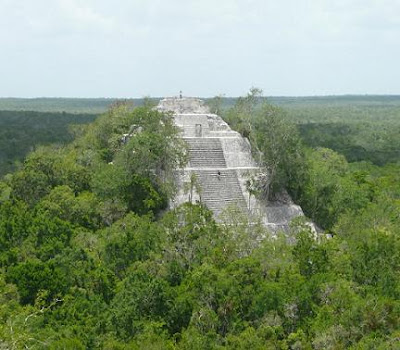Calakmul is the name given to site of one of the largest ancient Maya cities ever uncovered. It is also called as Kalakmul. It is located in the 1,800,000 acre Calakmul Biosphere Reserve in the Mexican state of Campeche, deep in the jungles of the greater Peten Basin region, 30 km from the Guatemalan border. The details of Calakmul are explained in world tour guides below. Calakmul was rediscovered from air by biologist Cyrus L. Lundell of the Mexican Exploitation Chicle Company on December 29, 1931, the find was reported to Sylvanus G. Morley of the Carnegie Institute at Chichen Itza in March 1932. According to Lundell, who named the site, in Maya, ca means two, lak means adjacent, and mul signifies any artificial mound or pyramid, so Calakmul is the City of the Two Adjacent Pyramids.
 Calakmul was a major Maya superpower within the northern Peten region of the Yucatan of southern Mexico. Calakmul administered a large domain marked by the extensive distribution of their emblem glyph of the snake head sign, to be read Kan. Calakmul was the seat of what has been dubbed the Serpent Head Polity. Calakmul itself is estimated to have had a population of 50,000 people and had governance, at times, to places as far away as 150 kms. There are 6,750 ancient structures identified at Calakmul the largest of which is the great pyramid at the site. Structure II is 55m high, making it the tallest of the Maya pyramids. Four tombs have been located within the pyramid. Like many temples or pyramids within Mesoamerica the pyramid at Calakmul increased in size by building upon the existing temple to reach its current size. The size of the central monumental architecture is approximately two square kilometers which is covered with dense residential structures is about twenty square kilometers.
Calakmul was a major Maya superpower within the northern Peten region of the Yucatan of southern Mexico. Calakmul administered a large domain marked by the extensive distribution of their emblem glyph of the snake head sign, to be read Kan. Calakmul was the seat of what has been dubbed the Serpent Head Polity. Calakmul itself is estimated to have had a population of 50,000 people and had governance, at times, to places as far away as 150 kms. There are 6,750 ancient structures identified at Calakmul the largest of which is the great pyramid at the site. Structure II is 55m high, making it the tallest of the Maya pyramids. Four tombs have been located within the pyramid. Like many temples or pyramids within Mesoamerica the pyramid at Calakmul increased in size by building upon the existing temple to reach its current size. The size of the central monumental architecture is approximately two square kilometers which is covered with dense residential structures is about twenty square kilometers.Calakmul is one of the most structure-rich sites within the Maya region. The site contains 117 stelae, the largest total in the region. Most are in paired sets representing rulers and their wives. However, because these carved stelae were produced in soft limestone, most of these stelae have been eroded beyond interpretation. Also many elaborate murals were discovered at Calakmul. Strangely, these murals do not represent activities of the elite class. Rather, they depict elaborate market scenes of people preparing or consuming products such as atole, tamales, or tobacco as an ointment. Also items being sold were textiles and needles. These murals also have glyphs within them describing the actions occurring.
The most prominent figure in these murals is identified as Lady Nine Stone; she appears in many scenes. This brings a world of the Maya marketplace to vibrant life for archaeologists. Another highly beneficial resource to Maya archeological understanding at Calakmul is the ceramic remains. The composition of the ceramic materials identifies the region or more specifically the polity that produced them. Ceramics with the snake emblem glyph found at several sites also give more evidence to identify ties or control over that site by Calakmul.

 Calakmul is located approximately 60 miles north of Tikal within the Peten, so they are relatively close to each other and inevitably were competing for the same resources. Calakmul acquired and influenced other outposts including many in the Tikal zone such as El Peru and Dos Pilas. Dos Pilas was originally created as an outpost for Tikal who implanted rulers from the royal lineage of the great city. Recently a hurricane ripped through the northern jungles of Guatemala and uncovered ten previously unknown glyph ridden stairs at the site of Dos Pilas, adding to the eight already known and deciphered steps of the hieroglyphic staircase #2, structure L5-49.
Calakmul is located approximately 60 miles north of Tikal within the Peten, so they are relatively close to each other and inevitably were competing for the same resources. Calakmul acquired and influenced other outposts including many in the Tikal zone such as El Peru and Dos Pilas. Dos Pilas was originally created as an outpost for Tikal who implanted rulers from the royal lineage of the great city. Recently a hurricane ripped through the northern jungles of Guatemala and uncovered ten previously unknown glyph ridden stairs at the site of Dos Pilas, adding to the eight already known and deciphered steps of the hieroglyphic staircase #2, structure L5-49.After a long period of inactivity following Morley's 1932 expedition, the city was explored by William Folan between 1984 and 1994, and is now the subject of a large-scale project of the National Institute of Anthropology and History under Ramon Carrasco.







No comments:
Post a Comment